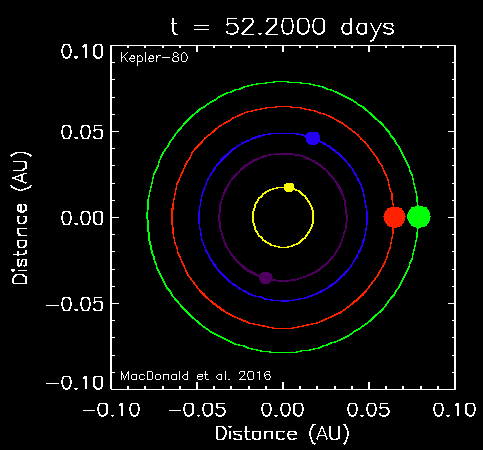Alien solar system boasts tightly spaced planets, unusual orbits

Tightly spaced planets inside an alien solar system known as Kepler-80 boast a rare orbital configuration.
The study was led by Mariah MacDonald as an undergraduate with Darin Ragozzine, an assistant professor of physics and space sciences, both at Florida Institute of Technology.
The unusual planetary array highlighted in the study deepens the ongoing examination of similar systems known as STIPs – Systems with Tightly-spaced Inner Planets – and contributes to the understanding of how Earth formed.
The findings will be published soon in the Astronomical Journal and are currently available at mmacdonald.altervista.org/kepler-80.html . MacDonald and Ragozzine gratefully acknowledge the support of 11 coauthors.
Located about 1,100 light years away, Kepler-80, named for the NASA telescope that discovered it, features five small planets orbiting in extreme proximity to their star. MacDonald and Ragozzine determined the nature of the exoplanetary system through measurements taken with the telescope.
As early as 2012, Kepler scientists found that all five planets orbit in an area about 150 times smaller than the Earth's orbit around the Sun, with "years" of about one, three, four, seven and nine days. The planets' close proximity to each other and their star allowed the Kepler Space Telescope to detect tiny variations (about 0.001 percent) in the length of their "years" due to their mutual gravitational interactions.
Analysis by MacDonald and her collaborators revealed that the outer four planets had masses about four- to six-times that of Earth, though they shared Earth's rocky composition. All four planets have masses similar to one another, though the two outermost planets are almost twice as big. This was attributed to a very puffy hydrogen/helium atmosphere.
These properties are not uncommon for exoplanets, but having precise compositional estimates for multiple planets in the same planetary system is rare.
Another rare attribute of the Kepler-80 system is that its planets have "synchronized" orbits. "The outer four planets return to almost exactly the same configuration every 27 days," said Ragozzine. This effect is known as a "resonance" and helps the system remain gravitationally stable.
The study also explained the origin of the synchronized orbits in general – and possibly the tightly-spaced configuration. In a process called migration, the orbits of these planets shrank over time while they were forming. Simulations clearly showed that this migration effect caused the planets to lock into synchronized orbits just like those seen with Kepler-80.
Kepler has discovered hundreds of other STIPs, which consist of three to seven relatively small and closely packed planets that complete orbits in 1 to 100 days. This new form of planetary system, quite different from our own solar system, is changing the way scientists think about how planets form, including the Earth. With all the knowledge gained by the analysis of Kepler-80, this system is granting important insight into how STIPs formed.
Journal information: Astronomical Journal
Provided by Florida Institute of Technology




















